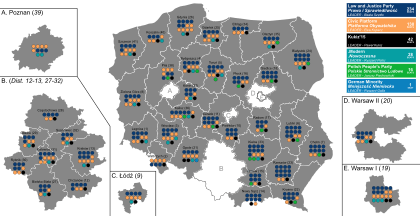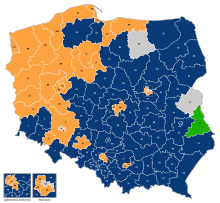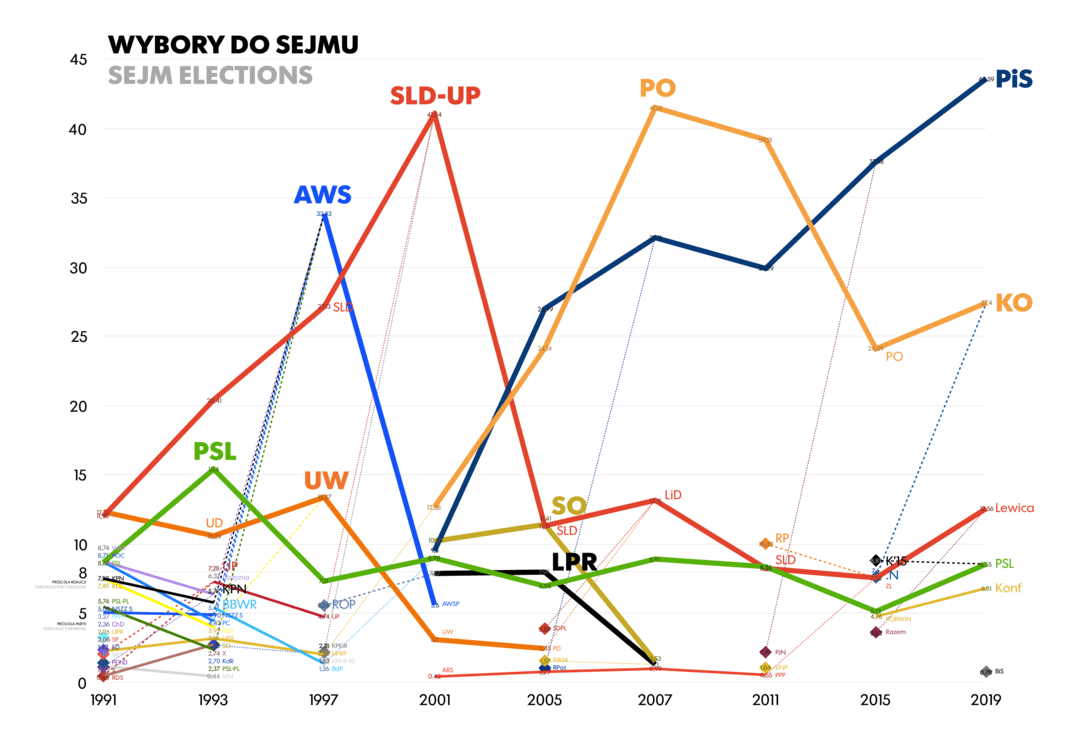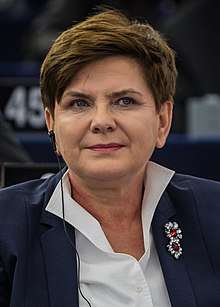2015 Polish parliamentary election
Parliamentary elections to both the Sejm and Senate were held in Poland on 25 October 2015.
| |||||||||||||||||||||||||||||||||||||||||||||||||||||||||||||||||||||||||||||||||||||||||||||||||||||
All 460 seats to the Sejm of Poland 231 seats are needed for a majority in the Sejm All 100 seats to the Senate of Poland | |||||||||||||||||||||||||||||||||||||||||||||||||||||||||||||||||||||||||||||||||||||||||||||||||||||
|---|---|---|---|---|---|---|---|---|---|---|---|---|---|---|---|---|---|---|---|---|---|---|---|---|---|---|---|---|---|---|---|---|---|---|---|---|---|---|---|---|---|---|---|---|---|---|---|---|---|---|---|---|---|---|---|---|---|---|---|---|---|---|---|---|---|---|---|---|---|---|---|---|---|---|---|---|---|---|---|---|---|---|---|---|---|---|---|---|---|---|---|---|---|---|---|---|---|---|---|---|---|
| Turnout | 50.92% | ||||||||||||||||||||||||||||||||||||||||||||||||||||||||||||||||||||||||||||||||||||||||||||||||||||
| |||||||||||||||||||||||||||||||||||||||||||||||||||||||||||||||||||||||||||||||||||||||||||||||||||||
 Seats won by Sejm District | |||||||||||||||||||||||||||||||||||||||||||||||||||||||||||||||||||||||||||||||||||||||||||||||||||||
| |||||||||||||||||||||||||||||||||||||||||||||||||||||||||||||||||||||||||||||||||||||||||||||||||||||
The election was won by the largest opposition party, the right-wing Law and Justice (PiS), with 37.6% of the vote against the governing Civic Platform (PO), which achieved 24.1%. Official results, announced on 27 October, gave Law and Justice 235 of 460 seats (51 percent), a majority of four.[1] PiS vice chairwoman Beata Szydło succeeded PO leader Ewa Kopacz as Prime Minister of Poland, heading a one-party cabinet.
It was the first election for a national parliament in Europe since the 1993 Norwegian elections in which the two largest parties were led by a female candidate, and the second election in history (also since the 1993 Norwegian election) where more than three parties fielded female leadership candidates. It was also the first election in Poland since the restoration of full democracy that a party won an absolute majority in the Sejm.
Electoral system
The process of election for the Sejm is through open party-list proportional representation via the D'hondt method in multi-seat constituencies, with a 5% national threshold for single parties and 8% threshold for coalitions (requirements waived for ethnic minorities). The senate is elected using first-past-the-post voting in single-member districts.[2] To be included on a ballot, a senate candidate must present 2,000 signatures of support from their constituents.[3] For Sejm elections, the threshold is 5,000 signatures per constituency, though that requirement is waived for parties that have already registered lists in at least half of all constituencies (21 out of 41 as of this election).[4]
Overall, the Sejm includes 460 MPs. Should a party have 231 or more deputies in Parliament, it has an absolute majority and can thus govern autonomously, without the need for support from other parties. The constitution can be amended with a supermajority of two-thirds, or 307 deputies.
Election date
The date of the election, 25 October, was set by the previous President of Poland, Bronisław Komorowski.[5] The latest possible date for the election to be held was in November 2015, four years after the previous election. Prior to the announcement of the election date, the most likely dates were thought to be in October or November.
In the previous parliamentary elections in 2011 the Civic Platform–Polish People's Party coalition government, in power since 2007, won a second term. All 460 seats in the Sejm and 100 seats in the Senate were up for election.
Parties standing in the election
Nationwide committees
Regional committees
Opinion polls

Results



The opposition party, Law and Justice won the election with 37.58% of the vote against the governing Civic Platform, which gained a 24.09% share.[28] Beata Szydło became the new Prime Minister, succeeding Ewa Kopacz.[29][30] Law and Justice became the first party in Poland to win majority government in a free election, since 1991. The other parties considered winners were two newcomer parties, Kukiz's Movement (third place) and Ryszard Petru's Modern party (4th place).
Two of the biggest losers were Civic Platform and the Polish People's Party. PO suffered its worst result in a parliamentary election in ten years, ending eight years of political dominance. The PSL, the junior partner in the outgoing government, had its worst result in 25 years (5.13%), just crossing the 5% threshold by a few thousand votes. Another perceived loser was the Democratic Left Alliance, Poland's largest left-wing party, which failed to win a seat for the first time since the change of system. The SLD ran as the largest partner of the United Left, which was 0.5% short of the 8% threshold for electoral alliances to win seats.
| Parties | Sejm | Senate | ||||||
|---|---|---|---|---|---|---|---|---|
| Votes | % | ±% | Seats | ± | Seats | ± | ||
| Law and Justice (Prawo i Sprawiedliwość, PiS) | 5,711,687 | 37.58 | 235 / 460 |
61 / 100 |
||||
| Civic Platform (Platforma Obywatelska, PO) | 3,661,474 | 24.09 | 138 / 460 |
34 / 100 |
||||
| Kukiz'15 (K'15) | 1,339,094 | 8.81 | 42 / 460 |
— | ||||
| Modern (Nowoczesna, .N) | 1,155,370 | 7.60 | 28 / 460 |
— | ||||
| United Left (Zjednoczona Lewica, ZL) | 1,147,102 | 7.55 | —[lower-alpha 1] | — | ||||
| Polish People's Party (Polskie Stronnictwo Ludowe, PSL) | 779,875 | 5.13 | 16 / 460 |
1 / 100 |
||||
| KORWiN | 722,999 | 4.76 | — | — | ||||
| Together (Partia Razem) | 550,349 | 3.62 | — | — | ||||
| Regional committees | ||||||||
| Committee of Zbigniew Stonoga (KWW ZS) | 42,731 | 0.28 | — | — | ||||
| German Minority (Mniejszość Niemiecka, MN) | 27,530 | 0.18 | 1 / 460 |
— | ||||
| United for Silesia (Zjednoczeni dla Śląska, ZdŚ) | 18,668 | 0.12 | — | — | ||||
| JOW Bezpartyjni | 15,656 | 0.10 | — | — | ||||
| Committee of Grzegorz Braun "God Bless You!" (Szczęść Boże!) | 13,113 | 0.09 | — | — | ||||
| Congress of the New Right (Kongres Nowej Prawicy, KNP) | 4,852 | 0.03 | — | — | ||||
| Self-Defence (Samoobrona) | 4,266 | 0.03 | — | — | ||||
| Social Movement of the Republic of Poland (Ruch Społeczny) | 3,941 | 0.03 | — | — | ||||
| Citizens to Parliament (Obywatele do Parlamentu, OdP) | 1,964 | 0.01 | — | — | ||||
| Independents (Niezależni) | N/A | N/A | N/A | N/A | N/A | 4 / 100 |
||
| Total | 15,200,671 | 100 | 460 | 100 | ||||
Notes
- United Left was running as a coalition, therefore was subject to an 8% election threshold rather than 5% for single parties.
By constituency
| Constituency | Turnout | PiS | PO | Kukiz'15 | Modern | ZL | PSL | KORWiN | Razem | MN | Others | Lead |
|---|---|---|---|---|---|---|---|---|---|---|---|---|
| 1 – Legnica | 46.71 | 35.70 | 25.24 | 9.59 | 7.15 | 10.45 | 3.89 | 4.32 | 3.64 | - | 0.00 | 10.46 |
| 2 – Wałbrzych | 44.83 | 31.15 | 32.65 | 8.81 | 6.64 | 8.76 | 3.18 | 4.30 | 3.41 | - | 1.09 | 1.50 |
| 3 – Wrocław | 54.08 | 31.21 | 30.49 | 8.74 | 10.65 | 6.10 | 2.60 | 5.22 | 4.21 | - | 0.77 | 0.72 |
| 4 – Bydgoszcz | 47.87 | 30.20 | 29.64 | 7.77 | 7.30 | 10.04 | 6.07 | 4.54 | 3.76 | - | 0.68 | 0.56 |
| 5 – Toruń | 44.90 | 33.57 | 25.77 | 8.32 | 6.50 | 10.76 | 6.75 | 3.90 | 3.65 | - | 0.78 | 7.80 |
| 6 – Lublin | 52.01 | 47.57 | 16.59 | 9.32 | 4.54 | 5.98 | 7.74 | 5.00 | 2.75 | - | 0.52 | 30.98 |
| 7 – Chełm | 45.30 | 48.02 | 12.31 | 10.47 | 3.75 | 7.11 | 11.39 | 4.37 | 2.39 | - | 0.18 | 35.71 |
| 8 – Zielona Góra | 44.63 | 28.27 | 28.21 | 8.75 | 9.99 | 10.02 | 5.12 | 4.99 | 3.99 | - | 0.65 | 0.06 |
| 9 – Łódź | 56.74 | 29.90 | 31.28 | 7.24 | 8.99 | 10.48 | 2.70 | 4.78 | 4.63 | - | 0.00 | 1.38 |
| 10 – Piotrków Trybunalski | 50.26 | 46.95 | 15.46 | 10.08 | 5.59 | 7.47 | 7.48 | 3.91 | 3.06 | - | 0.00 | 31.49 |
| 11 – Sieradz | 48.47 | 39.93 | 21.18 | 8.92 | 5.32 | 8.18 | 7.86 | 4.10 | 3.54 | - | 0.98 | 18.75 |
| 12 – Chrzanów | 54.46 | 49.05 | 20.42 | 8.67 | 5.79 | 5.33 | 3.03 | 4.45 | 3.26 | - | 0.00 | 28.63 |
| 13 – Kraków | 58.81 | 38.62 | 24.61 | 7.26 | 9.73 | 6.38 | 2.70 | 6.35 | 3.88 | - | 0.48 | 14.01 |
| 14 – Nowy Sącz | 52.18 | 60.56 | 13.95 | 7.83 | 3.69 | 2.55 | 4.16 | 4.31 | 2.13 | - | 0.80 | 46.61 |
| 15 – Tarnów | 51.85 | 51.99 | 14.71 | 9.60 | 4.54 | 3.41 | 8.08 | 4.72 | 2.43 | - | 0.53 | 37.28 |
| 16 – Płock | 46.22 | 43.78 | 16.44 | 8.41 | 5.15 | 8.14 | 10.66 | 4.07 | 3.35 | - | 0.00 | 27.34 |
| 17 – Radom | 49.38 | 47.49 | 17.55 | 8.41 | 4.81 | 4.82 | 9.42 | 3.91 | 2.62 | - | 0.98 | 29.94 |
| 18 – Siedlce | 50.56 | 51.10 | 13.55 | 8.36 | 4.63 | 4.35 | 10.23 | 4.35 | 2.66 | - | 0.76 | 37.55 |
| 19 – Warsaw I | 70.80 | 29.89 | 27.54 | 7.76 | 13.39 | 8.55 | 0.72 | 6.18 | 5.54 | - | 0.43 | 2.35 |
| 20 – Warsaw II | 60.00 | 38.80 | 25.12 | 7.22 | 10.01 | 5.66 | 3.80 | 4.81 | 3.85 | - | 0.73 | 13.68 |
| 21 – Opole | 43.12 | 27.77 | 26.23 | 12.57 | 7.14 | 6.75 | 3.68 | 3.95 | 3.02 | 8.14 | 0.75 | 1.54 |
| 22 – Krosno | 47.47 | 53.51 | 13.76 | 9.15 | 3.97 | 4.56 | 7.28 | 4.28 | 2.32 | - | 1.17 | 39.75 |
| 23 – Rzeszów | 52.56 | 56.11 | 13.11 | 9.28 | 4.16 | 4.42 | 4.67 | 4.96 | 2.29 | - | 1.00 | 43.00 |
| 24 – Białystok | 47.10 | 45.38 | 16.74 | 9.07 | 5.37 | 7.35 | 8.07 | 4.66 | 2.59 | - | 0.77 | 28.64 |
| 25 – Gdańsk | 52.55 | 29.61 | 34.72 | 7.15 | 9.17 | 6.59 | 3.02 | 5.00 | 3.98 | - | 0.75 | 5.11 |
| 26 – Gdynia | 51.28 | 31.22 | 33.46 | 8.02 | 8.22 | 6.64 | 3.23 | 4.43 | 4.05 | - | 0.75 | 2.24 |
| 27 – Bielsko-Biała | 56.35 | 40.42 | 23.57 | 9.36 | 8.27 | 6.56 | 3.42 | 4.68 | 3.72 | - | 0.00 | 16.82 |
| 28 – Częstochowa | 49.83 | 35.82 | 20.95 | 11.63 | 6.74 | 11.12 | 4.99 | 4.27 | 3.64 | - | 0.84 | 14.87 |
| 29 – Gliwice | 49.12 | 30.51 | 28.99 | 12.19 | 8.90 | 7.21 | 2.50 | 5.09 | 4.15 | - | 0.48 | 1.52 |
| 30 – Rybnik | 51.82 | 39.59 | 24.21 | 11.31 | 6.33 | 5.93 | 1.79 | 4.53 | 3.33 | - | 2.98 | 15.38 |
| 31 – Katowice | 53.92 | 32.92 | 28.37 | 10.05 | 8.66 | 6.77 | 0.99 | 5.55 | 4.08 | - | 2.61 | 4.55 |
| 32 – Sosnowiec | 51.41 | 29.65 | 25.56 | 10.24 | 8.97 | 13.97 | 2.35 | 4.81 | 4.44 | - | 0.00 | 4.09 |
| 33 – Kielce | 46.82 | 42.81 | 17.25 | 9.41 | 4.98 | 7.87 | 9.51 | 4.14 | 2.80 | - | 1.23 | 25.56 |
| 34 – Elbląg | 41.30 | 31.56 | 30.12 | 8.24 | 5.82 | 7.69 | 6.69 | 4.73 | 3.80 | - | 1.34 | 1.44 |
| 35 – Olsztyn | 43.13 | 30.42 | 27.07 | 8.97 | 6.82 | 8.76 | 8.44 | 5.10 | 3.74 | - | 0.68 | 3.35 |
| 36 – Kalisz | 47.27 | 31.85 | 24.69 | 7.98 | 7.04 | 8.82 | 10.98 | 4.25 | 3.17 | - | 1.23 | 7.16 |
| 37 – Konin | 46.64 | 37.41 | 20.23 | 8.83 | 6.94 | 11.77 | 6.86 | 3.99 | 3.98 | - | 0.00 | 17.18 |
| 38 – Piła | 46.07 | 27.26 | 31.02 | 9.01 | 6.98 | 9.15 | 7.66 | 4.07 | 3.92 | - | 0.93 | 3.76 |
| 39 – Poznań | 60.23 | 23.90 | 35.65 | 6.06 | 14.49 | 8.07 | 1.91 | 4.77 | 4.60 | - | 0.55 | 11.75 |
| 40 – Koszalin | 43.63 | 28.58 | 30.07 | 9.41 | 8.06 | 11.38 | 4.13 | 4.46 | 3.90 | - | 0.00 | 1.49 |
| 41 – Szczecin | 47.27 | 29.09 | 31.93 | 8.42 | 8.66 | 8.56 | 3.88 | 5.33 | 4.12 | - | 0.00 | 2.84 |
| Poland | 50.92 | 37.58 | 24.09 | 8.81 | 7.60 | 7.55 | 5.13 | 4.76 | 3.62 | 0.18 | 0.69 | 13.49 |
Reactions
Political analysts noted that the election marked the first time in the post-communist era that a political party received enough votes to form a majority government.[32][33] BBC News suggested that Law and Justice's strategy of putting forward Szydło as its candidate for prime minister was a "winning formula" in the election. Szydło was widely perceived as being more moderate than PiS' outspoken leader, Jarosław Kaczyński. However, it also noted that Kaczyński could step into the role of prime minister after the election.[33]
According to the Associated Press, the new Sejm was the most right-wing parliament in Europe due to the absence of centre-left MPs in the chamber. All five parties in the Sejm tilted rightward on social issues. Between them, left-leaning alliances only gained 11 percent of the vote.[34]
Kopacz swiftly conceded defeat after exit polls from TVP showed PiS on its way to a majority, while Kaczyński declared victory and hailed his party's historic majority.[35] Kaczyński also paid tribute to his late brother, President Lech Kaczyński, who died in the 2010 plane crash.[30]
See also
References
- "Poland's Eurosceptics win outright majority in parliament". Reuters. Retrieved 27 October 2015.
- Álvarez-Rivera, Manuel (17 October 2015). "Election Resources on the Internet: Elections to the Polish Sejm, Part I". electionresources.org. Retrieved 25 October 2015.
- "Notes on the Senate" (PDF). Senate of Poland. Retrieved 25 October 2015.
- "Sejm of the Republic of Poland". Sejm. Retrieved 25 October 2015.
- Rylukowski, Wojciech (17 July 2015). "Komorowski announces elections date". Warsaw Business Journal. Archived from the original on 21 October 2015. Retrieved 25 October 2015.
- "Polish premier's departure leaves party facing test". Financial Times.
- "Origin, Ideology and Transformation of Political Parties". google.de.
- "Pension Reforms in Central, Eastern, and Southeastern Europe". google.de.
- Copsey, Nathaniel (2013). Poland:An Awkward Partner Redeemed. The Member States of the European Union (Second ed.). Oxford University Press. p. 191.
- Szczerbiak, Aleks (2012). Poland Within the European Union: New awkward partner or new heart of Europe?. Routledge. p. 2.
- De Waele, Jean-Michel; Pacześniak, Anna (2012). The Europeanisation of Poland's political parties and party system. Europeanisation and Party Politics. ECPR Press. p. 125.
- Michael Minkenberg (2013). "Between Tradition and Transition: the Central European Radical Right and the New European Order". In Christina Schori Liang (ed.). Europe for the Europeans: The Foreign and Security Policy of the Populist Radical Right. Ashgate Publishing, Ltd. p. 261. ISBN 978-1-4094-9825-4.
- Lenka Bustikova (2018). "The Radical Right in Eastern Europe". In Jens Rydgren (ed.). The Oxford Handbook of the Radical Right. Oxford University Press. p. 574. ISBN 978-0-19-027455-9.
- Aleks Szczerbiak (2012). Poland Within the European Union: New Awkward Partner Or New Heart of Europe?. Routledge. p. 1. ISBN 978-0-415-38073-7.
-
- "Poland Bashes Immigrants, but Quietly Takes Christian Ones". The New York Times. 26 March 2019.
The far-right Law and Justice party came to power in 2015, at the height of Europe’s migrant crisis, after running a campaign that inspired choruses of “Poland for Poles.”
- "Poland's in crisis again. Here's what you should know about the far right's latest power-grab". The Washington Post. 28 November 2017.
Since taking control of both the presidency and the parliament in November 2015, Poland’s far-right Law and Justice (PiS) party has swiftly changed the rules for public media, the secret service, education, and the military.
- "EU's top court shows how to tackle autocrats". Financial Times. 27 June 2019.
Poland’s ultra-conservative Law and Justice (PiS) government followed suit last year.
- "Why will Poland not take in any Muslims?". Al Jazeera America. 8 November 2019.
Poland's ultra-conservative Law and Justice Party (PiS) won a second term in office last month, a victory that critics fear will accelerate the country's slide towards authoritarianism.
- "Poland's Government Is Systematically Silencing Opposition Voices". Foreign Policy. 31 May 2019.
Today, it is the main voice holding the ruling far-right Law and Justice (PiS) party accountable, while facing constant attacks from that government.
- "How Poland uses foreign lobbyists to fight PR wars and influence U.S. policy". Center for Responsive Politics. 19 February 2019.
Since the 2015 election of the far-right Law and Justice party in Poland, the country’s history with the Holocaust has become a point of contention with Israel.
- "Zack Blumberg: Europe's far right movements come on strong, but what next?". The Michigan Daily. 11 April 2019.
In the 2015 Polish parliamentary election, the far-right Law and Justice Party, or PiS, won with an outright majority (meaning they did not need to form a coalition to govern), something that had not been done in Poland since the fall of communism in 1989.
- "Revealed: dozens of European politicians linked to US 'incubator for extremism'". Open Democracy. 27 March 2019.
He had then recently left the far right Law and Justice (PiS) party over its failure to push through a constitutional amendment that would have banned abortion in all cases.
- "What to Make of the European Elections". The Atlantic. 30 May 2019.
In Poland, the far-right Law and Justice bested a broad alliance of moderate politicians.
- "Poland Bashes Immigrants, but Quietly Takes Christian Ones". The New York Times. 26 March 2019.
- "Poland's United Left puts forward candidate for PM". Polskie Radio dla Zagranicy.
- "Do Zjednoczonej Lewicy dołączył nowy koalicjant". interia.pl. 14 September 2015.
- "United Left presents its new leader and PM candidate". WBJ. Archived from the original on 6 October 2015. Retrieved 6 October 2015.
- "Start – Zjednoczona Lewica". Zjednoczona Lewica.
- Bundeszentrale für politische Bildung. "Marxismus". bpb.de.
- "Where Does the Left Come From?". internationalviewpoint.org.
- "Polska Partia Pracy". partiapracy.pl. Archived from the original on 3 July 2006. Retrieved 18 October 2015.
- "Maverick MEP Korwin-Mikke launches new party". Polskie Radio dla Zagranicy.
- "Maverick MEP Korwin-Mikke launches new party – National". Thenews.pl. 23 January 2015. Retrieved 5 March 2015.
- Rightist Party That Made Auschwitz Joke Wins Polish Elections Haaretz, 27 October 2015
- "Kulturalny flesz dnia: KUKIZ vs. PIERSI, WILDSTEIN vs. PESZEK, SHIRLEY TEMPLE". wpolityce.pl.
- Poland expected to turn inward under right-wing party The Washington Post, 26 October 2015
- Lyman, Nick (25 October 2015). "Law and Justice Party Wins in Poland's Parliamentary Elections". The New York Times. Retrieved 25 October 2015.
- "Poland conservatives 'win election'". BBC News. Retrieved 25 October 2015.
- Cienski, Jan (25 October 2015). "Polish right sweeps parliamentary elections". Politico. Retrieved 25 October 2015.
- "KOMUNIKAT PAŃSTWOWEJ KOMISJI WYBORCZEJ z dnia 26 października 2015 r. o zbiorczych wynikach głosowania na listy kandydatów na posłów w skali kraju" (PDF) (in Polish). pkw.gov.pl. 26 October 2015. Retrieved 27 October 2015.
- "Poland Ousts Government as Law & Justice Gains Historic Majority". Bloomberg. 25 October 2015. Retrieved 25 October 2015.
- "Poland elections: Conservatives secure decisive win". 25 October 2015. Retrieved 25 October 2015.
- Gaeta, Vanessa (28 October 2015). "Left wing is shut out in parliamentary vote in conservative Poland". The Boston Globe. Associated Press.
- "Eurosceptic conservatives win Polish election – exit poll". RTÉ News. 25 October 2015. Retrieved 25 October 2015.

.jpg)